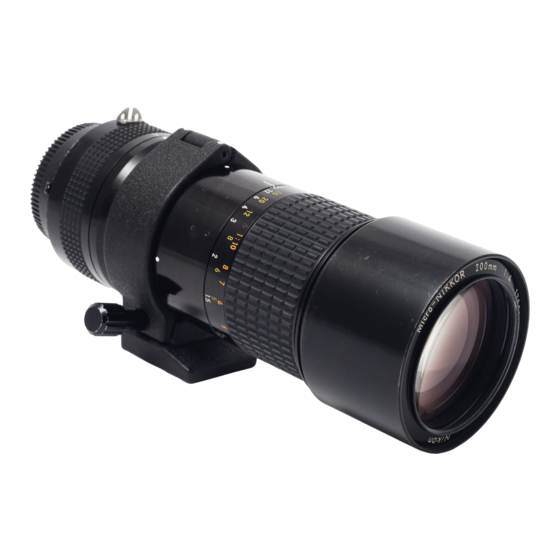
Table of Contents
Advertisement
Quick Links
Advertisement
Table of Contents

Summary of Contents for Nikon Micro-Nikkor 200mm f/4 IF
- Page 1 MicnoNikkor 200mm f/4IF Nikon INSTRUCTION MANUAL...
-
Page 2: Nomenclature
NOMENCLATURE Aperture scale index dot Meter coupling shoe Meter coupling ridge Aperture indexing post for Nikon SB-E Speedlight EE servo coupling post Aperture-direct- readout scale Aperture ring Tripod mounting collar Tripod collar alignment index dots Depth-of-field indicators Tripod collar locking screw... -
Page 3: Table Of Contents
CONTENTS NOMENCLATURE FOREWORD MOUNTING THE LENS FOCUSING Recommended Focusing Screens Focusing at a Predetermined Ratio Reproduction Ratio Depth of Field NOTES ON FOCUSING DETERMINING EXPOSURE With Built-in TTL Metering Without TTL Metering CLOSE-UP TABLES DEPTH-OF-FIELD TABLES FEATURES/SPECIFICATIONS 6 - 9 1 0 - 1 1 1 3 - 1 4... -
Page 4: Foreword
FOREWORD Representing a true breakthrough in lens design, the Micro-Nikkor 200mm f/4 IF is the world's first 200mm "micro" lens. By utiliz- ing internal focusing (IF), a system in which the lens elements move inside the lens, there is absolutely no increase in the overall length of the lens barrel as the lens is focused closer. -
Page 5: Mounting The Lens
MOUNTING THE LENS Position the lens in the camera's bayonet mount, aligning the aperture scale index dot on the lens with the lens mounting index on the camera body. Twist the lens counter- clockwise until it clicks into place. To remove, depress the lens release button on the camera and twist the lens clockwise. -
Page 6: Focusing
The fully automatic diaphragm of the Micro- Nikkor enables focusing with maximum image brightness throughout the entire focusing range of the lens. As the image is constantly viewed at the maximum aperture setting (i.e., f/4), the depth of field is minimized so that the image snaps in and out of focus rapidly and distinctly. -
Page 7: Recommended Focusing Screens
For screens used with Nikon cameras other than F3-and F2-series cameras (e.g., Nikon FA, FE2, FM2 and FE), refer to the columns for F3-series cameras. For the K2, B2 and E2 focusing screens, refer to the columns on the K, B and E screens, respective- ly. -
Page 8: Focusing At A Predetermined Ratio
(close to, or farther away from, the sub- ject) until the image appears sharp and crisp on the focusing screen. When the Nikon Teleconverter TC-301 is at- tached, the reproduction ratio increases to 1:1 and the automatic diaphragm still functions as before. -
Page 9: Depth Of Field
Depth of Field Depth of field refers to the zone of acceptable focus extending in front of and behind the plane of sharpest focus. As this zone is excep- tionally shallow at high reproduction ratios, previewing is desirable before shooting. To pre- view, press the depth-of-field button on the camera and the lens will close to the preselect- ed aperture to allow you to see how much... -
Page 10: Determining Exposure 1 0 - 1
The Micro-Nikkor has an automatic diaphragm Full-aperture with settings from f/4 to f/32 and couples to the Stop-down thru-the-lens meter of the Nikon F3, any Nikon F2 Photomic or other Nikon/Nikkormat cameras Stop-down for full-aperture exposure measurement over the Stop-down entire range of aperture settings. -
Page 11: Without Ttl Metering
Without T T L Metering A t close ranges (reproduction ratios greater than 1:10), the amount o f light reaching the film decreases as the extension between the lens and f i l m plane increases. When non-TTL measurement is used for this range, the result is underexposed photographs unless compensation has been made for this decrease. -
Page 12: Close-Up Tables
CLOSE-UP TABLES Lens in normal position attachment Subject field distance Close-Up Lens 164-58.7 1/7.1-1/1.5 No. 0 CIDK-Up Lens i-AV- 1/3.4-1/1.2 90.4-51.1 No. 1 Close-Up Lens S.-&- 1/1.7-1.2 56.7-42.8 No. I s w r E2 Ring 325-67.8 1/14-1/1-7 K Ring Set 1/35-1/1.2 728-64.3 s w r... -
Page 13: Depth-Of-Field Tables 1 3 - 1
DEPTH-OF-FIELD TABLES Focused distance f/5.6 0.71 0 . 7 0 9 - 0 . 7 1 1 0 . 7 0 9 - 0 . 7 1 1 0.80 0 . 7 9 9 - 0 . 8 0 1 0 . - Page 14 DEPTH-OF-FIELD TABLES - continued Focused distance f/5.6 2 * 4 " - 2 ' 4 " - 2*4-1/16" 2*4-1/16" 2 ' 5 - 1 5 / 1 6 " - 2 * 5 - 1 5 / 1 6 " - 2*6"...
-
Page 15: Features/Specifications
Nikon Teleconverter TC-301) Exposure measurement: method coupling ridge provided for Al cameras and meter coupling shoe for non-AI cameras Focusing system: Nikon Internal Focusing (IF) system Lens hood: Slip-out type built into front of lens Tripod mounting: Detachable tripod mount Attachment size: 52mm (P = 0.75mm) - Page 16 (except for brief quotation in critical articles or reviews), may be made without written authorization from NIKON CORPORATION. NIKON CORPORATION FUJI BLDG., 2-3, MARUNOUCHI 3-CHOME, CHIYODA-KU, TOKYO 100, JAPAN PHONE: 81-3-3214-5311 TELEX: NIKON J22601 FAX: 81-3-3201-5856 Nikon Printed in Japan 9&071-A08(S211)










Need help?
Do you have a question about the Micro-Nikkor 200mm f/4 IF and is the answer not in the manual?
Questions and answers